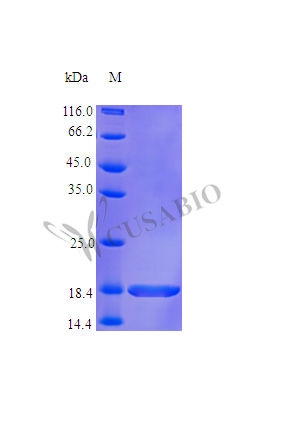Recombinant Human Kit ligand protein (KITLG) is produced in an E. coli expression system and contains amino acids 26-189 of the human sequence. This tag-free protein reaches over 97% purity based on SDS-PAGE analysis, which appears to make it well-suited for research work. The protein retains full biological activity, showing an ED50 of less than 2 ng/ml in cell proliferation assays with human TF-1 cells. This translates to a specific activity greater than 5.0 × 10^5 IU/mg. Endotoxin levels stay below 1.0 EU/μg, as measured by the LAL method.
KITLG, also known as stem cell factor, plays what seems to be a crucial role in hematopoiesis by driving proliferation and differentiation of hematopoietic stem cells. The protein participates in various cellular processes—mast cell development and function among them—and appears essential for immune response and pigmentation pathways. Researchers focus heavily on this protein because of its involvement in critical signaling pathways that regulate cell survival and proliferation.
Potential Applications
Note: The applications listed below are based on what we know about this protein's biological functions, published research, and experience from experts in the field. However, we haven't fully tested all of these applications ourselves yet. We'd recommend running some preliminary tests first to make sure they work for your specific research goals.
1. Cell Proliferation and Viability Assays
This recombinant KITLG protein is confirmed to be biologically active (ED₅₀ < 2 ng/ml in human TF-1 cells) and suitable for stimulating proliferation in KIT receptor-expressing hematopoietic cells. The high purity (>97%) and low endotoxin levels ensure reliable results in dose-response studies. However, since this is a partial protein (26-189aa), researchers should validate that the proliferative effects are comparable to full-length KITLG in their specific cell systems.
2. Receptor Binding and Interaction Studies
The biologically active KITLG is appropriate for studying KIT receptor interactions, but the partial sequence may affect binding kinetics compared to full-length KITLG. While the tag-free design ensures authentic binding measurements, researchers should note that the truncated form might not fully recapitulate the binding properties of native, full-length KITLG, particularly regarding receptor dimerization and downstream signaling complex formation.
3. Signal Transduction Pathway Analysis
This KITLG can be used to investigate downstream signaling cascades, but the partial nature may alter signaling amplitude or duration. The defined specific activity enables standardized experimental conditions, but researchers should validate that the signaling pathways activated by this truncated form match those stimulated by full-length KITLG, especially for complex pathways like PI3K/AKT and MAPK signaling.
4. Antibody Development and Validation
The high-purity KITLG serves as a good antigen for antibody development, but antibodies may not recognize full-length KITLG epitopes. While suitable for generating antibodies against the 26-189aa region, researchers should validate that the resulting antibodies also recognize native, full-length KITLG in biological samples for comprehensive immunological applications.
5. Protein-Protein Interaction Screening
This protein can be used in interaction studies, but the partial sequence may miss important binding domains present in the full-length protein. While the tag-free format is advantageous, any novel interactions identified should be validated with full-length KITLG to ensure biological relevance, as the truncated form might not represent complete interactome mapping.
Final Recommendation & Action Plan
This E. coli-expressed partial human KITLG protein (26-189aa) has validated biological activity and is suitable for most proposed applications, but researchers should be aware of limitations due to the truncated nature. For cell-based assays, confirm that the proliferative responses match those induced by full-length KITLG. For binding and interaction studies, consider that the partial protein might not fully represent native KITLG behavior. When developing antibodies, validate cross-reactivity with the full-length protein. The high purity and low endotoxin content make it particularly valuable for sensitive cell culture work, but critical findings should be verified with full-length KITLG when possible to ensure biological relevance.






